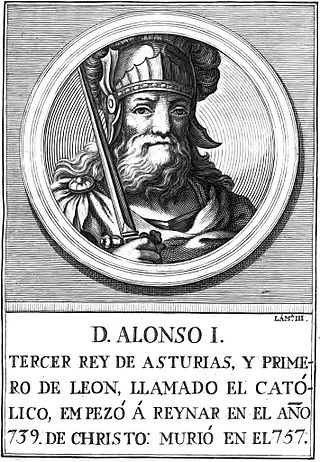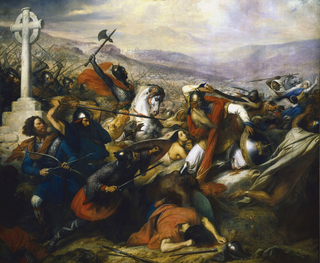The 740s decade ran from January 1, 740, to December 31, 749.
The 730s decade ran from January 1, 730, to December 31, 739.
The 720s decade ran from January 1, 720, to December 31, 729.
The 710s decade ran from January 1, 710, to December 31, 719.

Year 742 (DCCXLII) was a common year starting on Monday of the Julian calendar, the 742nd year of the Common Era (CE) and Anno Domini (AD) designations, the 742nd year of the 1st millennium, the 42nd year of the 8th century, and the 3rd year of the 740s decade. The denomination 742 for this year has been used since the early medieval period, when the Anno Domini calendar era became the prevalent method in Europe for naming years.

Year 740 (DCCXL) was a leap year starting on Friday of the Julian calendar, the 740th year of the Common Era (CE) and Anno Domini (AD) designations, the 740th year of the 1st millennium, the 40th year of the 8th century, and the 1st year of the 740s decade. The denomination 740 for this year has been used since the early medieval period, when the Anno Domini calendar era became the prevalent method in Europe for naming years.

Year 724 (DCCXXIV) was a leap year starting on Saturday of the Julian calendar, the 724th year of the Common Era (CE) and Anno Domini (AD)

Year 720 (DCCXX) was a leap year starting on Monday of the Julian calendar. The denomination 720 for this year has been used since the early medieval period, when the Anno Domini calendar era became the prevalent method in Europe for naming years.

Year 721 (DCCXXI) was a common year starting on Wednesday of the Julian calendar. The denomination 721 for this year has been used since the early medieval period, when the Anno Domini calendar era became the prevalent method in Europe for naming years.
Abd al-Rahman ibn Abd Allah Al-Ghafiqi, was an Arab Umayyad commander and governor who led Andalusian Muslim forces against the Franks. He is most famous for leading the Muslim forces during the Battle of Tours in 732. This battle, fought against the Frankish forces led by Charles Martel, was a significant moment in European history as it marked the halting of the Muslim expansion into Western Europe.

The siege of Avignon was contested in 737. Frankish forces led by Charles Martel defeated the Umayyad garrison of Avignon and destroyed the stronghold.
The siege of Narbonne was fought in 737 between the Arab and Berber Muslim forces of Yusuf ibn Abd al-Rahman al-Fihri, Arab Umayyad Muslim governor of Septimania on behalf of al-Andalus, and the Frankish Christian army led by the Carolingian duke Charles Martel.
The Battle of the River Berre was fought in 737 between the Arab and Berber Muslim forces of Yusuf ibn Abd al-Rahman al-Fihri, Arab Umayyad Muslim governor of Septimania on behalf of al-Andalus, and the Frankish Christian army led by the Carolingian duke Charles Martel during the siege of Narbonne. The battle, which took place at the mouth of the River Berre, was a significant victory for Charles Martel in the military campaigns of 736–737. During this period, Martel effectively prevented greater Umayyad expansion beyond the Pyrénées.
Septimania was the western region of the Roman province of Gallia Narbonensis that passed under the control of the Visigoths in 462. It passed briefly to the Emirate of Córdoba in the eighth century before its reconquest by the Franks, who by the end of the ninth century termed it Gothia. This article presents a timeline of its history.

The Umayyad invasion of Gaul, also known as the Islamic invasion of Gaul, refers to a series of military campaigns by Muslim forces to expand their territory into the region of Gaul, a continuation of the Umayyad conquest of the Iberian peninsula (711-726). The Umayyad invasion occurred in two phases, in 719 and 732 AD. Although the Umayyads secured control of Septimania, their incursions beyond this into the Loire and Rhône valleys failed. In 759, Muslim forces lost Septimania to the Christian Frankish Empire and retreated to the Iberian Peninsula which they called al-Andalus.

The Battle of the Baggage was fought between the forces of the Umayyad Caliphate and the Turkic Türgesh tribes in September/October 737. The Umayyads under the governor of Khurasan, Asad ibn Abdallah al-Qasri, had invaded the Principality of Khuttal in Transoxiana, and the local ruler called upon the Türgesh for aid. The Umayyad army retreated in haste before the Türgesh arrived, managing to cross the Oxus River just in time, while their rearguard engaged the pursuing Türgesh. The Türgesh crossed immediately after, and attacked the exposed Muslim baggage train, which had been sent ahead, and captured it. The main Umayyad army came to the rescue of the baggage train's escort, which suffered heavy casualties. The failure of the Umayyad campaign meant the complete collapse of the Arab control in the Upper Oxus valley, and opened Khurasan itself to the Türgesh.

The siege of Narbonne took place in France between 752 and 759, led by the Frankish king Pepin the Short against the Umayyad stronghold defended by an garrison of Arab and Berber Muslim troops who had invaded Septimania and occupied the Visigothic Kingdom and its Gallo-Roman inhabitants since 719. The siege remained as a key battlefield in the context of the Carolingian expedition south to Provence and Septimania starting in 752.
Abu Hatim al-Harith ibn Surayj ibn Yazid was an Arab leader of a large-scale social rebellion against the Umayyad Caliphate in Khurasan and Transoxiana. Harith's rebellion began in 734 and represented the grievances of both the local Arab settlers as well as the native Iranian converts, who were not recognized as equal to the Arab Muslims, against the Umayyad regime. Harith based his revolt on religious grounds and won over a large part of both the Arab settlers and the native population, but failed twice to capture the provincial capital of Marw. The rebellion was finally suppressed by Asad ibn Abdallah al-Qasri in 736. Along with a few supporters, Harith escaped capture and allied himself with the heathen Türgesh. Harith accompanied the Türgesh qaghan Suluk in his invasion deep into Arab-held territory, which was decisively beaten back in the Battle of Kharistan in 737. With Türgesh power collapsing thereafter, Harith remained in Transoxiana supported by the native princes. Asad's successor, Nasr ibn Sayyar, campaigned against Harith and his native supporters, but eventually, hoping to use him to bolster his position in the Arab inter-tribal rivalries, Nasr secured for Harith a pardon from the Caliph. Harith returned to Marw in 745. Soon however he raised a sizeable armed force and challenged Nasr's authority, until he was killed in a clash with his ally Juday al-Kirmani in 746. His revolt weakened Arab power in Central Asia and facilitated the beginning of the Abbasid Revolution that would overthrow the Umayyads.
Sa'id ibn Amr al-Harashi was a prominent Arab general and governor of the Umayyad Caliphate, who played an important role in the Arab–Khazar wars.









